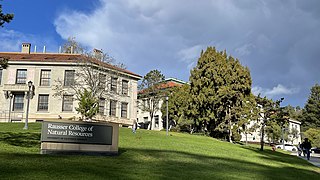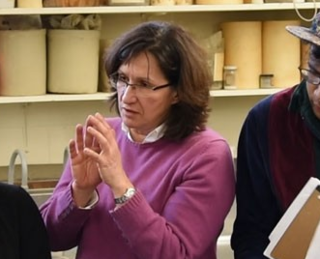Agricultural science is a broad multidisciplinary field of biology that encompasses the parts of exact, natural, economic and social sciences that are used in the practice and understanding of agriculture. Professionals of the agricultural science are called agricultural scientists or agriculturists.
The following outline is provided as an overview of and topical guide to agriculture:

Bangladesh Agricultural University, was established in 1961. It is the first agricultural university, and also the second largest public university of Bangladesh. This university is located in Mymensingh. The university has 44 departments.

The Norwegian University of Life Sciences is a public university located in Ås, Norway. It is located in Akershus county and has around 7,700 students.

Assam Agricultural University (AAU) is an agricultural education state university which was established on 1 April 1969 in Jorhat in the state of Assam, India. The jurisdiction of the university extends to the entire State of Assam with regard to teaching, research and extension education in the field of agriculture and allied sciences. The university has a number of campuses with its headquarters at Borbheta, Jorhat.Assam Assembly Passes Veterinary And Fishery University Bill The Assam government has decided to form a new university by merging the existing veterinary colleges in the state and the fishery college at Raha.This new University will consist of five Krishi Vigyan Kendra's viz., Kamrup, Barpeta, Baksa, North Lakhimpur and Morigaon under it and the two research stations viz., Mandira and Byrnihat.
The University of British Columbia (UBC) is a Canadian public research university with campuses in Vancouver and Kelowna, British Columbia. The following is a list of faculties and schools at UBC.

The Rausser College of Natural Resources (RCNR), or Rausser College, is the oldest college at the University of California, Berkeley and in the University of California system. Established in 1868 as the College of Agriculture under the federal Morrill Land-Grant Acts, CNR is the first state-run agricultural experiment station. The college is home to four internationally top-ranked academic departments: Agriculture and Resource Economics; Environmental Science, Policy, and Management; Nutritional Sciences and Toxicology; and Plant and Microbial Biology, and one interdisciplinary program, Energy and Resources Group. Since February 2020, it is named after former dean and distinguished professor emeritus Gordon Rausser after his landmark $50 million naming gift to the college.
The University of British Columbia Okanagan is a campus of the University of British Columbia in Kelowna, British Columbia, Canada.
The College of Food, Agricultural and Natural Resource Sciences (CFANS) is one of seventeen colleges and professional schools at the University of Minnesota. The College offers 14 majors, 3 pre-major and pre-professional majors and 26 freestanding minors for undergraduate students and a variety of graduate study options that include master's, doctoral and joint degree programs.

Sokoine University of Agriculture (SUA) is a public university in Morogoro, Tanzania, specializing in agriculture. The university is named after the country's second prime minister Edward Sokoine.
Expenditures by Canadian universities on scientific research and development accounted for about 40% of all spending on scientific research and development in Canada in 2006.

The UBC Farm is a 24-hectare farm and forest system on the southern end of the University of British Columbia (UBC) campus in Vancouver, British Columbia, Canada. The farm is operated by the Centre for Sustainable Food Systems, which is part of the Faculty of Land and Food Systems, and has existed in its current form since 2000. It hosts a variety of crops and fruits, as well as some animals and composting facilities. Several academic programs allow the students to use the farm for research and teaching.

The Luiz de Queiroz College of Agriculture is a unit of the University of São Paulo involved with research, teaching and extension of services in agriculture, animal husbandry, agricultural and related sciences. The school's main campus, located in Piracicaba, São Paulo, is home to seven undergraduate and eighteen graduate programs. In addition, the school maintains exchange agreements with many other institutions of the world, and welcome exchange students of several nationalities.
North Carolina State University's College of Agriculture and Life Sciences (CALS) is the fourth largest college in the university and one of the largest colleges of its kind in the nation, with nearly 3,400 students pursuing associate, bachelor's, master's and doctoral degrees and 1,300 on-campus and 700 off-campus faculty and staff members.
The University of Maryland College of Agriculture and Natural Resources is the agricultural and environmental sciences college of the University of Maryland and operates the Maryland Sea Grant College in cooperation with the University of Maryland Center for Environmental Science and the National Oceanic and Atmospheric Administration.

Vietnam National University of Agriculture, until 2014 Hanoi University of Agriculture (HUA), is an education and research university specializing in the agricultural sector. The university is located in Trau Quy town, Gia Lam district, a Hanoi suburban area, about 12 km far from Hanoi city centre.
The Colorado State University College of Agricultural Sciences includes five academic departments and offers nine undergraduate majors with many concentration options as well as multiple graduate degree programs. People in the College of Agricultural Sciences lead research and design projects in food production, security, and safety, ecosystem health, landscape design, and human well-being. They also provide extension and participate in engagement in agricultural sciences and landscape architecture.

Maja Krzic is a soil scientist and an associate professor in the Department of Forest & Conservation Sciences in the Faculty of Forestry with a joint appointment in the Applied Biology and Soil Sciences programs in the Faculty of Land and Food Systems at the University of British Columbia. She is a founder of the Virtual Soil Science Learning Resources Group, a collaborative teaching effort among scientists, students, and multimedia experts from seven universities and three research institutions in Canada that create open access soil science educational resources. She is also the president of the Canadian Society of Soil Science and was named a 3M National Teaching Fellow in 2016.

The Lilongwe University of Agriculture and Natural Resources (LUANAR) is a university outside Lilongwe, Malawi. It was formed in 2011 by a merger between Bunda College of Agriculture of the University of Malawi and Natural Resources College (NRC).

The University of Connecticut's College of Agriculture, Health, and Natural Resources (CAHNR) is the oldest of UConn's fourteen colleges, and teaches a wide range of subjects. It is the oldest agricultural school in Connecticut, originally established with two purposes, conducting agriculture research and teaching practical skills to modernize farming. The college describes its mission as working "toward a global sustainable future." To that end, besides conducting research and teaching, the college's faculty also work together with Connecticut communities on projects related to food systems, agriculture, human health, nutrition and physical activity, and environmental science.









